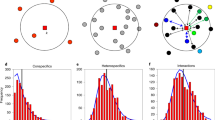Abstract
A neighbourhood-based competition model for plant individuals is studied to evaluate how a hierarchical structure related to size may emerge in plant communities. It is shown by numerical simulations and linear stability analysis that many stable states exist in the hierarchical structure when both the total number of individuals and the degree of asymmetry of competition are high. When the hierarchical structures are self-organized by the dynamic instability of the homogeneous state due to non-linearity of competition, it is proved that these states are always locally stable. The relevance of the results to size structures in real plant communities (boreal forests vs tropical and temperate forests) is discussed. This is suggested to be the mechanism responsible for the coexistence of species in plant communities.
Similar content being viewed by others
References
Aikman, D. P. and A. R. Watkinson (1980). A model for growth and self-thinning in evenaged monocultures of plants. Ann. Bot. 45, 419–427.
Chesson, P. and N. Huntly (1989). Short-term instabilities and long-term community dynamics. Trends Ecol. Evol. 4, 293–298.
Ellison, A. M. and D. Rabinowitz (1989). Effects of plant morphology and emergence timeon size hierarchy formation in experimental populations of two varieties of cultivated peas (Pisum sativum). Am. J. Bot. 76, 427–436.
Firbanks, L. G. and A. R. Watkinson (1985). A model of interference within plant monocultures. J. Theor. Biol. 116, 291–311.
Fowler, N. L. (1988). What is a safe site?: neighbor, litter, germination date and patch effects. Ecology 69, 947–961.
Gates, D. J., A. J. O’Connor and M. Westcott (1979). Partitioning the union of disks in plant competition models. Proc. R. Soc. Lond. Ser. A. 367, 59–79.
Hara, T. (1988). Dynamics of size structure in plant populations. Trends Ecol. Evol. 3, 129–133.
Hara, T., M. Kimura and K. Kikuzawa (1991). Growth patterns of tree height and stem diameter in populations of Abies veitchii, A. mariesii and Betula ermanii. J. Ecol. 79, 1085–1098.
Harper, J. L. (1977). Population Biology of Plants, London: Academic Press.
Hartgerink, A. P. and F. A. Bazzaz (1984). Seedling-scale environmental heterogeneity influences individual fitness and population structure. Ecology 65, 198–206.
Hozumi, K. (1975). Studies on the frequency distribution of the weight of individual trees in a forest stand V. The M — w diagram for various types of forest stands. Jpn J. Ecol. 25, 123–131.
Keddy, P. A. and B. Shipley (1989). Competitive hierarchies in herbaceous plant communities. Oikos 54, 234–241.
Kikuzawa, K. and K. Umeki (1996). Effect of canopy structure on degree of asymmetry of competition in two forest stands in northern Japan. Ann. Bot. 77, 565–571.
Kohyama, T. (1993). Size-structured tree populations in gap-dynamic forest—the forest architecture hypothesis for the stable coexistence of species. J. Ecol. 81, 131–143.
Lundqvist, L. (1994). Growth and competition in partially cut sub-alpine Norway spruce forests in northern Sweden. For. Ecol. Manage. 65, 115–122.
May, R. M. (1972). Will a large complex system be stable? Nature 238, 413–414.
Richards, P. W. (1976). The Tropical Rain Forest: An Ecological Study?, Cambridge: Cambridge University Press.
Ross, M. A. and J. L. Harper (1972). Occupation of biological space during seedling establishment. J. Ecol. 64, 77–88.
Sakaguchi, H. (1994). Hierarchical structures in Lotka—Volterra type equations. Phys. Lett. A196, 38–42.
Schwinning, S. and G. A. Fox (1995). Population dynamic consequences of competitive symmetry in annual plants. Oikos 72, 422–432.
Schwinning, S. and J. Weiner (1998). Mechanisms determining the degree of size asymmetry in competition among plants. Oecologia 113, 447–455.
Solbrig, O. T. (1981). Studies on the population biology of the genus Viola. II. The effect of plant size on fitness in Viola sororia. Evolution 35, 1080–1093.
Stoll, P., J. Weiner and B. Schmid (1994). Growth variation in a naturally established population of Pinus sylvestris. Ecology 75, 660–670.
Thomas, S. C. and F. A. Bazzaz (1993). The genetic component in plant size hierarchies: norms of reaction to density in Polygonum species. Ecol. Monogr. 63, 231–249.
Turner, D. M. and D. Rabinowitz (1983). Factors affecting frequency distribution of plant mass: the absence of dominance and suppression in competing monocultures of Festuca paradoxa. Ecology 64, 469–475.
Wall, R. and M. Begon (1985). Competition for fitness. Oikos 44, 356–360.
Waltman, P. (1983). Competition Models in Population Biology, Philadelphia: Society for Industrial and Applied Mathematics.
Warner, R. R. and P. L. Chesson (1985). Coexistence by recruitment fluctuations: a field guide to the storage effect. Am. Nat. 125, 769–787.
Weiner, J. (1990). Asymmetric competition in plant populations. Trends Ecol. Evol. 5, 360–364.
Weiner, J. and S. C. Thomas (1986). Size variability and competition in plant monocultures. Oikos 47, 211–222.
Wyszomirski, T. (1986). Growth, competition and skewness in a population of one-dimensional individuals. Ecol. Pol. 34, 615–641.
Yodzis, P. (1987). Competition for Space and the Structure of Ecological Communities, Berlin: Springer-Verlag.
Yokozawa, M. and T. Hara (1992). A canopy photosynthesis model for the dynamics of size structure and self-thinning in plant populations. Ann. Bot. 70, 305–316.
Yokozawa, M. and T. Hara (1995). Foliage profile, size structure and stem diameter—plant height relationship in crowded plant populations. Ann. Bot. 76, 271–285.
Yokozawa, M. and T. Hara (1999). Global versus local coupling models and theoretical stability analysis of size-structure dynamics in plant populations. Ecol. Model. 118, 61–72.
Yokozawa, M., Y. Kubota and T. Hara (1996). Crown architecture and species coexistence in plant communities. Ann. Bot. 78, 437–447.
Yokozawa, M., Y. Kubota and T. Hara (1998). Effects of competition mode on spatial pattern dynamics in plant communities. Ecol. Model. 106, 1–16.
Zobel, M. (1992). Plant species coexistence—the role of historical, evolution and ecological factors. Oikos 65, 314–320.
Author information
Authors and Affiliations
Rights and permissions
About this article
Cite this article
Yokozawa, M. Size hierarchy and stability in competitive plant populations. Bull. Math. Biol. 61, 949–961 (1999). https://doi.org/10.1006/bulm.1999.0120
Received:
Accepted:
Issue Date:
DOI: https://doi.org/10.1006/bulm.1999.0120




